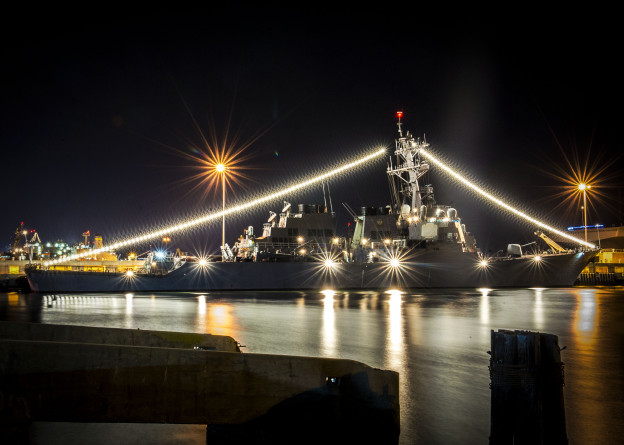
The Navy needs to perfect three technologies on its quest for its next generation of large warships, Rear Adm. Thomas Rowden, director of surface warfare (N96) for the Office of the Chief of Naval Operations (OPNAV) told USNI News in an interview in the Pentagon on Jan. 9.
Energy weapons (like lasers), electromagnetic rail guns and advanced energy systems to power the new weapons are all likely to be part of the next major surface ship, though the specifics for a ship (or ships) — which won’t begin construction in 15 years — are far from settled.
“There’s some technologies we have to work through,” he said.
“I’d like to say that it’s going to be a week and a half, but the unfortunate reality is that we have to have time for the technology to mature.”
The Navy is now in the very early stages of starting new warship designs for a ship Rowden estimates will begin construction in 2028 and enter the fleet in the 2030s.
“It takes about 15 years to work your way methodically through to field these types of ships that we’re talking about building,” he said.
The early steps for the next generation of warships follow the service’s failed attempt to create a new trio of surface ships in the 2000s that would replace the existing Arleigh Burke-class (DDG-51) destroyers, Ticonderoga-class (CG-47) cruisers and Oliver Hazard Perry-class frigates (FFG-7).
The next generation cruiser (CG(X)) was cancelled and the Zumwalt-class destroyer (DDG-1000) was truncated to three hulls — both actions due to the cost of the proposed ships. The much lower cost Littoral Combat Ship (LCS) was the only ship to survive the original three-ship concept.
However the three remaining Zumwalts will serve as a de facto test bed for technologies — including the ships integrated power system (IPS) — that can be incorporated into the 2028 ships, Rowden said.
Zumwalt’s IPS system allows the ship to use its main engines — usually only tied to a ship’s propulsion system — to power a hull-wide electrical grid increasing the amount of power available for high energy systems like lasers, rail guns and radars.
Rail guns and lasers — though requiring high amounts of electrical power — hold the promise of more cost effective weapons costing less per round than missiles costing hundreds of thousands of dollars. The power output of DDG-1000s IPS make the Zumwalt a likely early candidate for both types of technology.
“We are going to cut our teeth on DDG-1000 and on the IPS we have on that ship,” Rowden said.
“I think a lot of the technologies that we are putting on 1000 to 1002 are going serve us very well as we drive toward these [new] ships.”
Part of that concept will include the ability for the Navy to upgrade ships faster with a higher degree of so-called modularity.
“More often that not we don’t decommission ships because they’ve reached the end of their service lives, we decommission ships because the development of the threats have outpaced the [ship’s] ability to keep up with them,” Rowden said.
“Is there a smarter way as we build the ships of the future, we can make sure that we are building in the capability to upgrade ships to keep them relevant throughout their service life?”
In looking toward the next set of ships, N96 has begun talks with Naval Sea Systems Command’s Program Executive Office (PEO) Ships and PEO Integrated Weapon Systems on how to keep the new designs relevant over their lifespan, “without having to take the ships out for significant period of time to upgrade,” Rowden said.
The modularity Rowden envisions would not be on the same level as the LCS, where the ship could take on an entirely different mission set quickly, but provide an ability so ships could upgrade weapons and systems faster than the current crop of cruisers and destroyers.
The fundamental missions of the new designs would be the same as the current surface force: sea control (anti-surface warfare), providing an inner screen for undersea threats to assets like aircraft carriers and guarding the fleet from aircraft and missiles. But the ships might be more specialized than multi-mission hulls currently in service.
“I could see where we build ships that are focused on the execution of integrated air and missile defense with some ability to execute the war at sea and some power projection capability and other ships that are more closely oriented toward anti-submarine warfare,” Rowden said.
In the meantime the bulk of the surface force will be based on the DDG-51 design, which first commissioned in the early 1990s. The navy has plans to create a Flight III version of the ship that will begin procurement in 2016.





